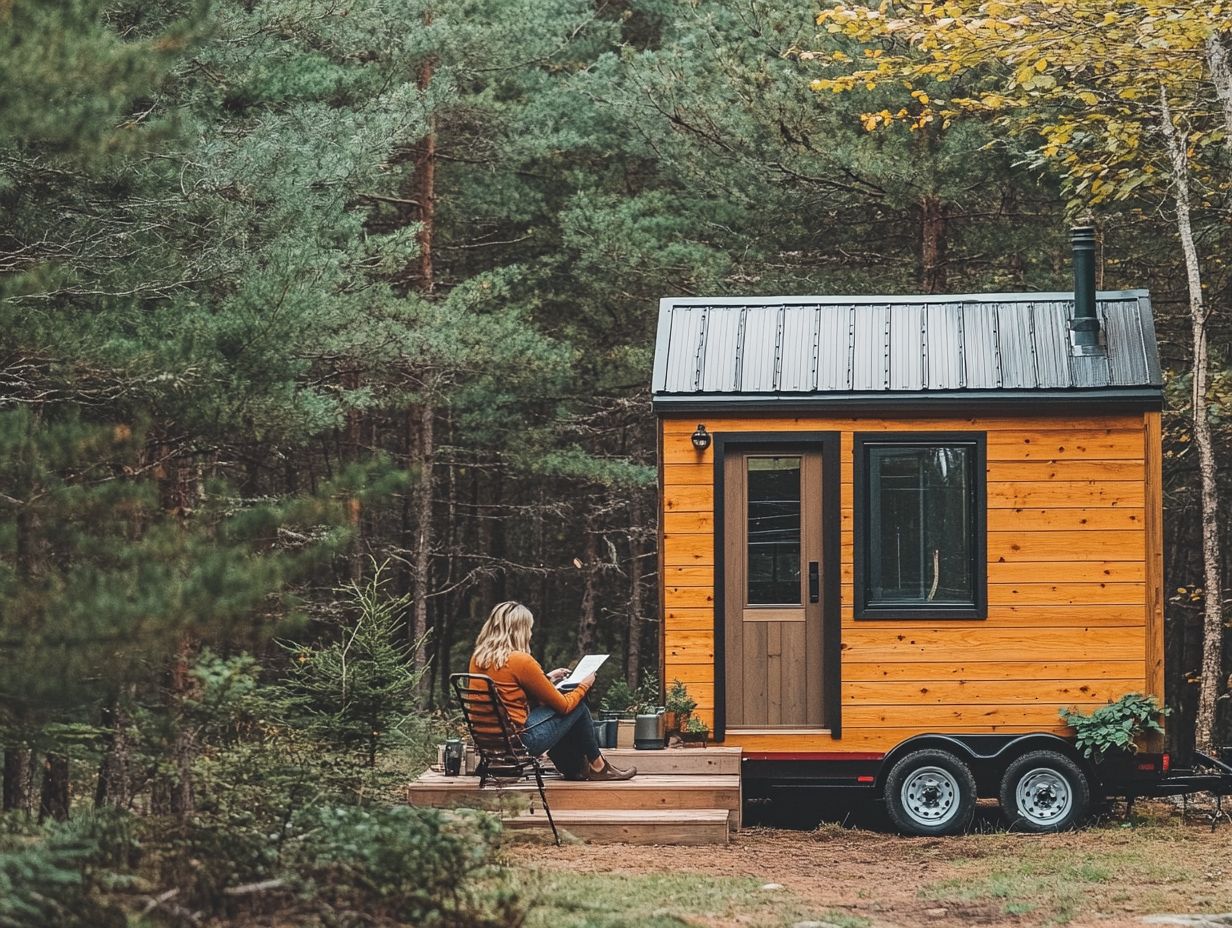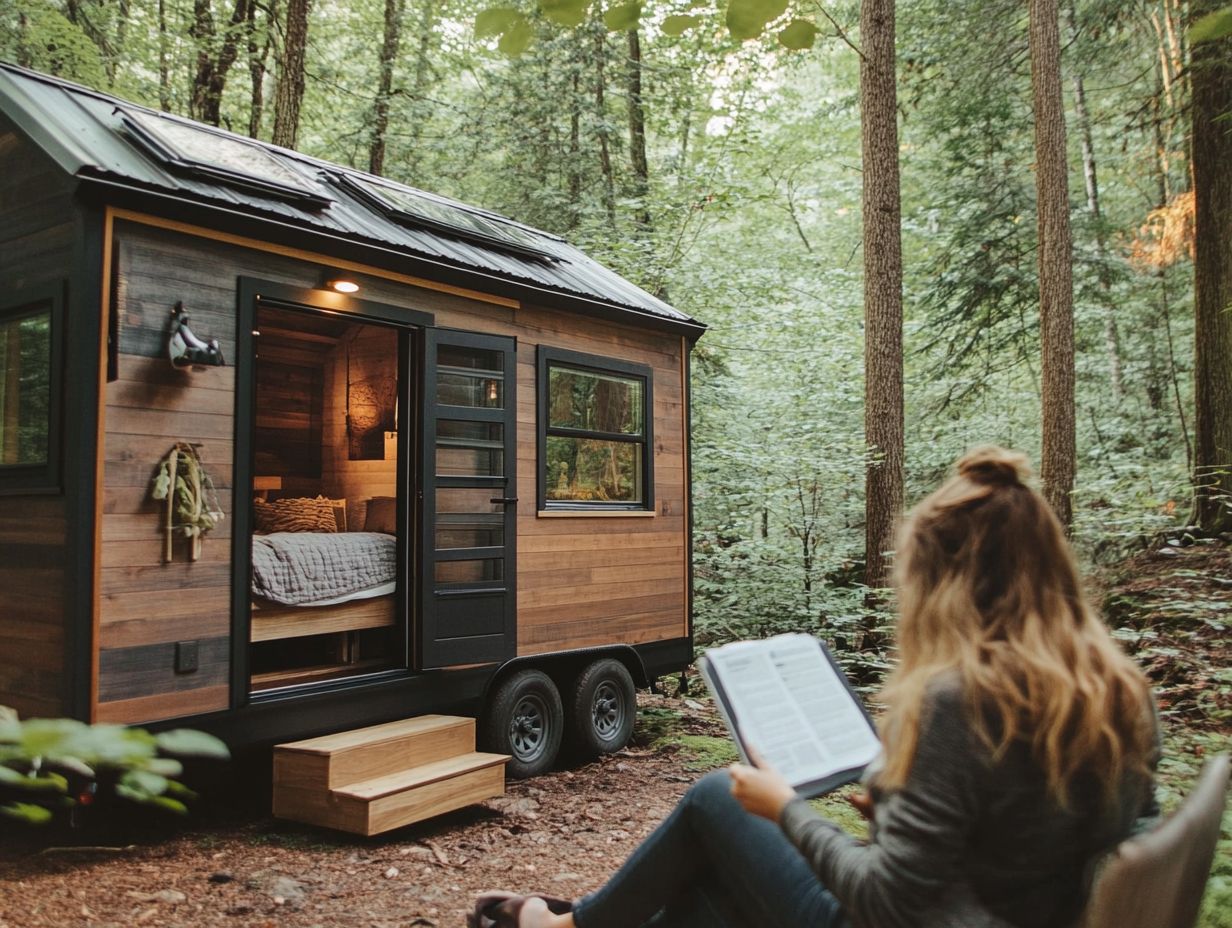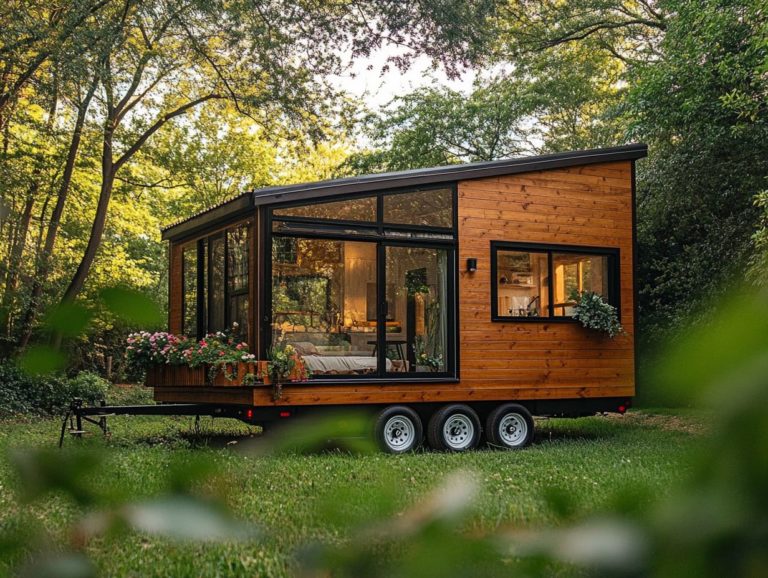How to Handle Tiny House Regulations?
Tiny houses have captured your imagination, presenting an opportunity for a minimalist lifestyle and a chance to reconnect with nature. However, understanding tiny house rules can feel overwhelming.
This article delves into what tiny houses are and underscores the importance of knowing regulations for those aspiring to own one. You ll find a breakdown of zoning laws and building codes, along with tips for researching local regulations. Get ready to turn your tiny house dreams into reality!
We will also explore alternative living options, such as mobile tiny homes and communities.
Contents [hide]
Key Takeaways:
- Learn about zoning laws and building codes to ensure your tiny house complies with regulations.
- Research local laws and regulations before starting your tiny house project.
- Consider joining a tiny house community or building a temporary or mobile tiny house to bypass strict regulations.
Why Tiny House Regulations Matter
Understanding tiny house regulations is essential for anyone drawn to the tiny house movement, which supports simple and affordable living. Tiny houses, whether on wheels or a fixed foundation, are gaining traction both in the United States and in places like California, Texas, and Florida.
However, navigating the associated regulations can be quite complex. Tiny house laws vary significantly by state and local jurisdictions, encompassing zoning regulations and building codes that dictate where and how these homes can be constructed or parked.
As you embark on your tiny house development journey, you must grasp the nuances of these regulations to ensure compliance and secure the necessary approvals.
What are Tiny Houses?
Tiny houses are compact and efficient living spaces that typically range from 100 to 400 square feet, perfectly embodying the principles of the tiny house movement that champions simplified living and sustainability.
These versatile dwellings provide a cost-effective alternative to traditional housing, appealing to eco-conscious individuals and families eager to minimize their carbon footprint. By focusing on quality over quantity, you can embrace a minimalist lifestyle that reduces clutter and highlights only the possessions that truly matter.
Variations abound; you might consider tiny houses on wheels for the mobility and freedom they offer, or opt for structures firmly anchored on foundations, providing a sense of stability and permanence. These choices enable you to tailor your living situation to your unique needs while embracing an environmentally friendly lifestyle. However, it’s important to be aware of local regulations, so navigating local ordinances for tiny houses can help you make informed decisions.
Why are Regulations Important?
Tiny house regulations ensure safety. They also help integrate your home into the local community. They cover everything from building codes and zoning regulations to the approval processes essential for tiny home living.
Understanding these regulations safeguards your investment and nurtures a positive relationship with your neighborhood. By following these guidelines, you can steer clear of costly legal troubles and fines while also upholding community values and standards.
Compliance with local laws helps minimize risks like overcrowding or structural failures, leading to a safer living environment.
Moreover, embracing these regulations promotes sustainable practices. It encourages responsible resource use and environmentally friendly construction methods, benefiting not just you but also the broader community.
Zoning Laws and Building Codes
Zoning laws and building codes are pivotal in shaping the landscape for tiny houses, influencing not only their placement but also the standards they must adhere to, as outlined by the International Building Code and the International Residential Code.
Understanding these regulations is essential for ensuring that your tiny house meets all necessary requirements and can be situated in your desired location.
How do Zoning Laws Affect Tiny Houses?

Zoning laws are crucial for tiny houses. They determine where these homes can be located, affecting community availability and lifestyle feasibility.
These regulations often impose minimum lot sizes and outline whether tiny houses are permitted in residential zones. Understanding tiny house zoning laws presents considerable hurdles for those wishing to downsize.
In places like California, cities such as Los Angeles are adapting their regulations to allow tiny homes in designated areas as a response to pressing housing shortages. On the flip side, Texas has earned a reputation for its more lenient stance, actively encouraging tiny home developments with fewer zoning restrictions, as detailed in the tiny house regulations guide.
However, for residents grappling with stringent zoning laws, you can take action by advocating for special permissions or exploring alternative options like RV parks that are more accommodating to the burgeoning tiny house movement. Additionally, it’s crucial to understand navigating tiny house community regulations to make informed decisions.
Building Codes for Tiny Houses
Building codes for tiny houses are essential. They lay down the safety, health, and structural integrity requirements necessary for your tiny home. These codes ensure that your dwelling complies with either the International Building Code or the International Residential Code.
These regulations protect you from potential hazards and ensure that your home can withstand various environmental factors. While building codes cover the technical specifics necessary for construction, zoning regulations dictate land use and determine where your tiny house can be situated. For more information on this topic, check out tiny house building codes, as they influence aspects like how many buildings can be on a piece of land and property use.
For tiny homes, specific requirements often include minimum ceiling heights to guarantee comfortable living conditions, adherence to safety standards, and a thorough approval process for innovative designs. To ensure compliance, it’s crucial to understand how to navigate tiny house legalities. Together, these elements not only promote safe living environments but also foster harmonious integration into communities.
Navigating Tiny House Regulations
Navigating the complexities of tiny house regulations demands meticulous research and a solid grasp of state-specific tiny house laws. It’s essential to engage in effective communication with local building officials to secure the necessary approvals and ensure full compliance.
Empower yourself with knowledge and proactive dialogue to make your tiny house dreams a reality.
Start researching today to find the perfect location for your tiny home!
Researching Local Laws and Regulations
Researching local laws and regulations is essential for anyone contemplating tiny home living. These rules can vary significantly from one state to another and profoundly affect the feasibility of owning a tiny house.
Understanding these regulations goes beyond mere legality; it directly shapes your future living experience. One effective way to gather this information is through online resources, such as tiny house legal resources you should know, where you can find local zoning maps and ordinances readily available. Visiting local government offices allows you to gain deeper insights and ask pertinent questions that relate specifically to your unique situation.
Engaging with community organizations focused on sustainable living or the tiny house movement can also provide invaluable guidance and support. It’s crucial to familiarize yourself with the specific tiny house laws in your state along with any unique requirements such as minimum size dimensions, utility connections, and necessary permits. Understanding the importance of zoning ensures compliance and sustainability for your tiny home journey.
Working with Building Officials
Working with building officials is a crucial step in your tiny house approval journey. These professionals offer invaluable guidance on complying with local regulations and help you navigate tiny house laws.
Building a solid rapport with these officials can greatly influence your project’s success. Approach them well-prepared, armed with necessary documents like detailed plans, site assessments, and zoning information.
Understanding their expectations is essential; they prioritize following safety rules and sustainability considerations. By being proactive and responsive, you foster positive relationships and streamline the approval process.
Consider building officials as the gatekeepers ensuring that tiny house projects meet community standards. Their support can pave the way for innovative housing solutions that redefine your living experience.
Alternative Options for Tiny House Living

Exploring alternative options for tiny house living, such as temporary and mobile tiny houses, provides you with unparalleled flexibility. These choices cater to your desire for affordable housing solutions aligned with the tiny house movement.
Temporary and Mobile Tiny Houses
Temporary and mobile tiny houses offer a flexible living solution that adapts to various regulations and lifestyles while providing an affordable housing option.
These compact dwellings enable you to explore diverse locations without the permanent ties of traditional homes. Mobile tiny houses can be parked in settings ranging from picturesque nature spots to vibrant urban centers, encouraging a lifestyle rooted in simplicity and mindfulness while significantly reducing living costs. However, it’s important to understand tiny house laws that every owner should know.
As you embrace minimalism, you ll cultivate meaningful experiences and deeper connections within your community. You can blend adventure with sustainability, enriching your life through travel and an evolving environment.
Joining a Tiny House Community
Joining a tiny house community offers amazing benefits that you’ll love. It creates a nurturing environment that encourages connection and resource sharing, helping you navigate the intricacies of tiny house laws.
Within these communities, you ll find communal facilities like shared gardens, workspaces, and social areas that foster collaboration. Living alongside like-minded individuals presents opportunities for shared experiences from organizing events to swapping tips on sustainable living.
Tiny house communities often understand local regulations well. This support keeps you informed about compliance requirements, allowing your dream of tiny living to align with local zoning laws and building codes.
Frequently Asked Questions
What are tiny house regulations?
Tiny house regulations are rules and guidelines set by local, state, and federal governments that dictate the construction, zoning, and living requirements for tiny houses. These regulations vary by location and can affect where you can build and live in a tiny house.
Do I need to follow tiny house regulations?

Yes, it’s important to follow local regulations when building or living in a tiny house. Ignoring these regulations can lead to fines, legal issues, or even the forced removal of your tiny house.
Start your tiny house journey today!
How do I know which regulations apply to me?
Regulations for tiny houses can vary greatly depending on location. Research your area’s specific regulations before you start construction or move into a tiny house.
Can I legally live in a tiny house on my own property?
This depends on local laws. Some areas allow tiny houses on private property, while others may restrict or ban this practice. Understanding these regulations is crucial before making decisions.
Are there specific building codes for tiny houses?
Many places consider tiny houses as non-traditional housing and they might not adhere to the same rules as traditional homes. However, some areas do have specific codes that must be followed. Research these codes thoroughly before beginning construction.
What should I do if my area doesn’t have regulations for tiny houses?
Even if there are no specific rules for tiny houses in your area, follow all relevant building codes and zoning laws. Reach out to local officials or organizations for guidance on building and living in a tiny house.






